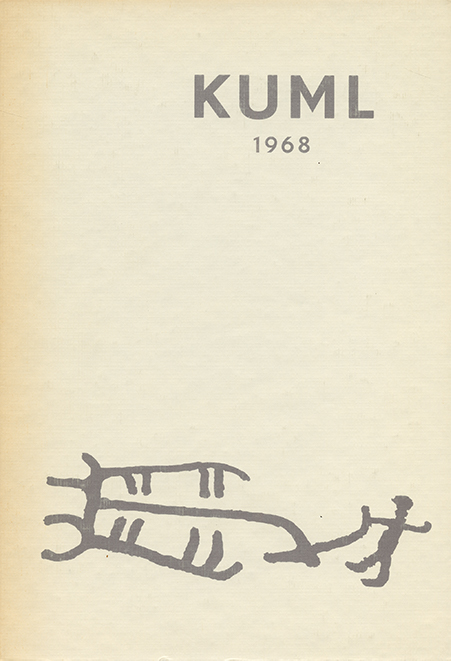Furreby-hjulet
DOI:
https://doi.org/10.7146/kuml.v19i19.105134Nøgleord:
furreby, wheel, hjul, bronzewheel, bronzehjul, wheel ornaments, hjul ornament, Viking age, vikingetidResumé
The Furreby Wheel
In the summer of 1959 I found a little bronze wheel at Furreby in Vendsyssel. It lay on a wind-blown slope by the sea among potsherds from the Roman Iron-Age, arrowheads and sherds from the Late Neolithic, and steatite sherds from the Viking Period.
The wheel (Figs. 1 .and 2: 1) is of the same type as the wheels on the Oseberg wagon (and one from Lindholm Høje) (fig. 2: 2-3) which have a large hub and a broad fellow, consisting of several pieces fixed together by dowels. The number of spokes is the same, 12, and there are also 12 spokes on a similar wheel from Grave 844 at Birka fig. 2: 4-7. We know from Birka that wheels of this type occur in women's graves and that they hung on the breast suspended from the neck by a chain or string, employing either the hole in the hub or an eye in the felloe. Judging by the stylized Carolingian plant ornamentation, the Furreby wheel, which must be considered a native product, should be assigned to the period around or just following 900 A. D.
Wheel ornaments occur in all prehistoric periods subsequent to the invention of the spoked wheel and, in Lapland at least, also in the Early Middle Ages.
The Anglo-Saxons, Merovingians and Alamanni were sometimes buried with miniature wheels. In the case of the Alamanni, they occur exclusively in women's graves, having featured as decorative discs on small round bags which hung on a chain from the belt. Similar discs have been recovered from Nordic finds (e. g. Gotland and Bornholm). Contemporary with and accompanying the Nordic gold bracteates, there are also small wheelshaped ornaments of gold. From the Roman Iron-Age there are numerous finely decorated wheel ornaments.
In Yugoslavia, the rich grave of an Illyrian prince of the Early Iron Age contained a small wheel with a string of amber beads (fig. 4: 5). Small wheels could also hang on fibulae in that period (fig. 4: 1-2). From the Pre-Roman Iron Age, wheels with an eye for suspension are relatively common in Denmark, especially the type with a large hubring in the centre (fig. 4: 3) -a type which was current in South Germany as early as Period II of the Bronze Age (fig. 4: 4).
In the Bronze Age, wheel ornaments could be found in most of Europe (and Asia) especially in the Urnfield and Hallstatt Periods (fig. 5: 1-2). In Scandinavia, examples have been found at Härnevi in Uppland and Magleby, Nørrekjær in Zealand (fig. 5: 3). Wheelshaped discs for attachment to the cheek guards of horses' bits also occur.
It seems that the origin of wheel ornaments should be sought in the Early Bronze Age. They are commonly found in Mycenean graves (fig. 6: 1-3), and have perhaps, like the Mycenean chariots with spoked wheels, their origin in Anatolia or the Orient. From Mycenae, the custom of bearing wheel ornaments spread into Europe, often in connection with the amber trade. Suddenly, they occur in connection with wheel pins, (fig. 6: 4), which presumably originated as a cross between Unêtice pins with a disc-shaped head and wheel pendants.
From this period, there is a unique Danish find of a bronze wheel in an oak-coffin burial, the wheel apparently having lain on the breast of the interred woman. The size of the wheel (17.7 cm. in diameter) exceeds both that of the miniature wagon-wheels and of the other wheel ornaments, but this large wheel seems nevertheless to belong to the latter group.
The conventional interpretation of the wheel ornaments is that they are sun emblems, which is in fact the case with the Sumerians, Babylonians and Assyrians, where they hang in necklaces with symbols of the planet Venus and the moon (fig. 8: 1-2). On the other hand, the wheel meant something quite different to the Iranians, whose four-spoked wheel was the earth wheel and six-spoked wheel the celestial wheel. In Christian art the wheel attains a new significance: the four-spoked wheel is the victory cross and the six-spoked the monogram of Christ. To the Gauls, the wheel was the emblem of the sky- and thunder god Taranis, and for the Buddhists the eight-spoked wheel is the symbol of the eightfold path to the attainment of Nirvana. Among the Romans, small wheels were borne by both children and soldiers as protective amulets, and to the present day wheels figure as pendants on horse harness, to ward off the "evil eye".
It is therefore very difficult to say what significance a wheel ornament has had for its wearer, especially when it is found out of context. It would seem too hazardous to take refuge in the sun theory, when so many other interpretations are possible.
Søren KroghDownloads
Publiceret
Citation/Eksport
Nummer
Sektion
Licens
Fra og med årgang 2022 er artikler udgivet i Kuml med en licens fra Creative Commons (CC BY-NC-SA 4.0).
Alle tidligere årgange af tidsskriftet er ikke udgivet med en licens fra Creative Commons.


